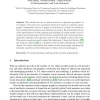Free Online Productivity Tools
i2Speak
i2Symbol
i2OCR
iTex2Img
iWeb2Print
iWeb2Shot
i2Type
iPdf2Split
iPdf2Merge
i2Bopomofo
i2Arabic
i2Style
i2Image
i2PDF
iLatex2Rtf
Sci2ools
EMMCVPR
2005
Springer
2005
Springer
Retrieving Articulated 3-D Models Using Medial Surfaces and Their Graph Spectra
We consider the use of medial surfaces to represent symmetries of cts. This allows for a qualitative abstraction based on a directed acyclic graph of components and also a degree of invariance to a variety of transformations including the articulation and deformation of parts. We demonstrate the use of this representation for both indexing and matching 3-D object models. Our formulation uses the geometric information associated with each node along with an eigenvalue labeling of the adjacency matrix of the subgraph rooted at that node. We present comparative results against the techniques of shape distributions [17] and harmonic spheres [12] on a database of 320 models representing 13 object classes. The results demonstrate that medial surface based graph matching significantly outperforms these techniques for objects with articulating parts.
| Added | 27 Jun 2010 |
| Updated | 27 Jun 2010 |
| Type | Conference |
| Year | 2005 |
| Where | EMMCVPR |
| Authors | Juan Zhang, Kaleem Siddiqi, Diego Macrini, Ali Shokoufandeh, Sven J. Dickinson |
Comments (0)

